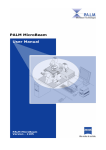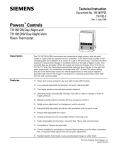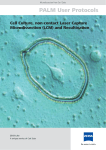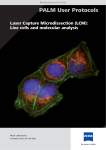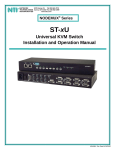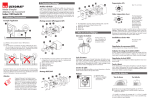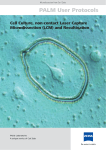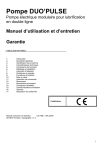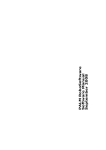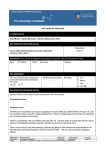Download PALM MicroBeam User Manual
Transcript
PALM® MicroBeam User Manual PALM® MicroBeam User Manual - 0202 Z This document is delivered only to persons who are trained and authorized by P.A.L.M. Microlaser Technologies AG. No part of this document may be reproduced or distributed in any form or by any means without the prior written consent of P.A.L.M. Microlaser Technologies AG. The information in this document is subject to change without notice. P.A.L.M. Microlaser Technologies AG assumes no responsibility for any errors that may appear. Printed June 2002 Second Edition The following technologies have been patented by P.A.L.M. Microlaser Technologies: - Laser catapult technology (Laser Pressure Catapulting LPCpat) Patents: US 5,998,129, EP 879408 B1 and others. Three-dimensional laser beam positioning system Patents: US 5,689,109, EP 679325 B1 and others. Additional patents pending. P.A.L.M. Microlaser Technologies AG Am Neuland 9+12 82347 Bernried / Germany Phone: +49-(0)8158-9971-0 Fax: +49-(0)8158-9971-249 E-mail: [email protected] www.palm-microlaser.com ©P.A.L.M. Microlaser Technologies AG, 2001. All rights reserved. 2 PALM® MicroBeam User Manual - 0202 Z List of Contents Content Chapter Page 1 1.1 1.2 1.3 Important Basic Information . . . . . . . . . . . . . . . . . Legal Notes . . . . . . . . . . . . . . . . . . . . . . . . . . . . . . . Conventions for this User Manual . . . . . . . . . . . . . . . . How You Can Contact Us . . . . . . . . . . . . . . . . . . . . . . 2 Installation . . . . . . . . . . . . . . . . . . . . . . . . . . . . . . . . . . . . . . . . . . . . . . . . . . . . . . . . . . . . . 6 3 3.1 Operating Room . . . . . . . . . . . . . . . . . . . . . . . . . . . . . . . . . . . . . . . . . . . . . . . . . . . . . . . . . 6 Admissible Ambient Conditions. . . . . . . . . . . . . . . . . . . . . . . . . . . . . . . . . . . . . . . . . . . . . . . 6 4 4.1 4.2 4.3 4.4 4.5 4.6 4.7 Safety . . . . . . . . . . . . . . . . . . . . . . . . . . . . . . . . . . . . . . What You Should Do in an Emergency Case . . . . . . . . . . . . Observe the User Manual. . . . . . . . . . . . . . . . . . . . . . . . . Laser Safety. . . . . . . . . . . . . . . . . . . . . . . . . . . . . . . . . . Safety Markings and Type Plate . . . . . . . . . . . . . . . . . . . . Qualification of the Staff . . . . . . . . . . . . . . . . . . . . . . . . . Points that must strictly be observed . . . . . . . . . . . . . . . . Pay Attention to Remaining Risks and Preventive Measures . 4.7.1 Remaining Risks and Protective Measures – Laser . . . 4.7.2 Remaining Risks – Electricity . . . . . . . . . . . . . . . . . 4.7.3 Remaining Risks – Infectious Material . . . . . . . . . . . 4.7.4 Remaining Risks – EMV . . . . . . . . . . . . . . . . . . . . . 4.7.5 Remaining Risks – Fire Extinction . . . . . . . . . . . . . . How to Ensure a Safe and Ecological Disposal . . . . . . . . . . 4.8 The PALM® MicroBeam - Survey. . . . . . . . . . . . . PALM® ControlUnit . . . . . . . . . . . . . . . . . . . . . . . . Laser Interface . . . . . . . . . . . . . . . . . . . . . . . . . . . Laser. . . . . . . . . . . . . . . . . . . . . . . . . . . . . . . . . . Microscope Adapter. . . . . . . . . . . . . . . . . . . . . . . . Microscope Zeiss Axiovert 200 . . . . . . . . . . . . . . . . 5.5.1 Fluorescence attachment . . . . . . . . . . . . . . . 5.6 PALM® RoboStage . . . . . . . . . . . . . . . . . . . . . . . . 5.7 PALM® CapMover . . . . . . . . . . . . . . . . . . . . . . . . . 5.7.1 Control Apparatus . . . . . . . . . . . . . . . . . . . . 5.8 Mechanical Manipulator . . . . . . . . . . . . . . . . . . . . . 5.9 CCD Video Camera . . . . . . . . . . . . . . . . . . . . . . . . 5.10 Computer . . . . . . . . . . . . . . . . . . . . . . . . . . . . . . 5 5.1 5.2 5.3 5.4 5.5 6 6.1 6.2 6.3 6.4 6.5 6.6 How to Prepare the PALM® MicroBeam Switch On/Off the Device. . . . . . . . . . . . . 6.1.1 Switch On the Device . . . . . . . . . . 6.1.2 Switch Off the Device . . . . . . . . . . CCD Video Camera Adapter . . . . . . . . . . . Check of the Laser in the Microscope . . . . Laser energy and focus . . . . . . . . . . . . . . 6.4.1 Laser Energy Adjustment . . . . . . . . 6.4.2 Laser Focus Correction . . . . . . . . . Adjust Laser Focus . . . . . . . . . . . . . . . . . Cutting speed. . . . . . . . . . . . . . . . . . . . . PALM® MicroBeam User Manual - 0202 Z . . . . . . . . . . . . . . . . . . . . . . . . . . . . . . . . . . . . . . . . . . . . . . . . . . . . . . . . . . . . . . . . . . . . . . . . . . . . . . . . . .......................... ......................... ......................... ......................... 5 5 5 5 ........................... 7 .......................... 7 .......................... 7 .......................... 7 .......................... 8 .......................... 9 .......................... 9 .......................... 9 . . . . . . . . . . . . . . . . . . . . . . . . . . .9 . . . . . . . . . . . . . . . . . . . . . . . . . . .9 . . . . . . . . . . . . . . . . . . . . . . . . . . .9 . . . . . . . . . . . . . . . . . . . . . . . . . . 10 . . . . . . . . . . . . . . . . . . . . . . . . . . 10 . . . . . . . . . . . . . . . . . . . . . . . . . 10 . . . . . . . . . . . . . . . . . . . . . . . . . . 11 . . . . . . . . . . . . . . . . . . . . . . . . . 12 . . . . . . . . . . . . . . . . . . . . . . . . . 12 . . . . . . . . . . . . . . . . . . . . . . . . . 13 . . . . . . . . . . . . . . . . . . . . . . . . . 13 . . . . . . . . . . . . . . . . . . . . . . . . . 14 . . . . . . . . . . . . . . . . . . . . . . . . . . 15 . . . . . . . . . . . . . . . . . . . . . . . . . 15 . . . . . . . . . . . . . . . . . . . . . . . . . 16 . . . . . . . . . . . . . . . . . . . . . . . . . . 16 . . . . . . . . . . . . . . . . . . . . . . . . . 16 . . . . . . . . . . . . . . . . . . . . . . . . . 17 . . . . . . . . . . . . . . . . . . . . . . . . . 17 for the Application . . . . . . . . . . . . . . . . . . . . . . . 18 . . . . . . . . . . . . . . . . . . . . . . . . . . . . . . . . . . . . . 18 . . . . . . . . . . . . . . . . . . . . . . . . . . . . . . . . . . . . . . 18 . . . . . . . . . . . . . . . . . . . . . . . . . . . . . . . . . . . . . . 18 . . . . . . . . . . . . . . . . . . . . . . . . . . . . . . . . . . . . . 18 . . . . . . . . . . . . . . . . . . . . . . . . . . . . . . . . . . . . . 18 . . . . . . . . . . . . . . . . . . . . . . . . . . . . . . . . . . . . . 19 . . . . . . . . . . . . . . . . . . . . . . . . . . . . . . . . . . . . . . 20 . . . . . . . . . . . . . . . . . . . . . . . . . . . . . . . . . . . . . . 20 . . . . . . . . . . . . . . . . . . . . . . . . . . . . . . . . . . . . . 21 . . . . . . . . . . . . . . . . . . . . . . . . . . . . . . . . . . . . . 22 3 List of Contents 7 7.1 PALM® MicroBeam with Fluorescence Illumination . . . . . . . . . . . . . . . . . . . . . . . . . . . . . 22 Operate the Microscope with Fluorescence Illumination . . . . . . . . . . . . . . . . . . . . . . . . . . . . . 22 7.1.1 Simultaneous Fluorescence Observation . . . . . . . . . . . . . . . . . . . . . . . . . . . . . . . . . . . 22 8 8.1 8.2 8.3 Trouble Shooting List . . . . . . . . . . . . . . . . . . . . . Laser is not cutting . . . . . . . . . . . . . . . . . . . . . . . . No video image . . . . . . . . . . . . . . . . . . . . . . . . . . Shift between drawing and cutting . . . . . . . . . . . . . . . . . . . . . . . . . . . . . 9 9.1 9.2 Maintenance of the PALM® MicroBeam Laser. . . . . . . . . . . . . . . . . . . . . . . . . . . Microscope. . . . . . . . . . . . . . . . . . . . . . . 9.2.1 Cleaning of the Optical Parts . . . . . 9.2.2 Cleaning When Actually Dirty . . . . . . . . . . . . . . . . . . . . . . . . . . . . . . . . . . . . . . . . . . . . . . . . 25 . . . . . . . . . . . . . . . . . . . . . . . . . . . 25 . . . . . . . . . . . . . . . . . . . . . . . . . . . 25 . . . . . . . . . . . . . . . . . . . . . . . . . . . . 25 . . . . . . . . . . . . . . . . . . . . . . . . . . . . 25 ...... ...... ...... ...... ...... . . . . . . . . . . . . . ......................... ........................ ........................ ........................ 23 23 24 24 10 Technical Data . . . . . . . . . . . . . . . . . . . . . . . . . . . . . . . . . . . . . . . . . . . . . . . . . . . . . . . . . 26 10.1 Electricity . . . . . . . . . . . . . . . . . . . . . . . . . . . . . . . . . . . . . . . . . . . . . . . . . . . . . . . . . . . . 26 10.2 Nitrogen Laser . . . . . . . . . . . . . . . . . . . . . . . . . . . . . . . . . . . . . . . . . . . . . . . . . . . . . . . . . 26 4 PALM® MicroBeam User Manual - 0202 Z Important Basic Information 1 Legal Notes Important Basic Information Congratulations! With your new PALM® MicroBeam you obtained the State-of-the-Art Technology in microdissection and micromanipulation. The PALM® MicroBeam is a high precision instrument, which allows to perform microdissection in nearly every kind of research as well as in routine examination with a high throughput. To meet a very high safety standard and to use all the benefits of your PALM® MicroBeam you should read this user´s manual carefully and observe all instructions given in this manual. Please follow also the instructions for the single components of your PALM® MicroBeam especially for the microscope, the fluorescence attachment (option), the video camera and the laser. P.A.L.M. Microlaser Technologies will not be responsible for mistakes and possible consequences caused by non-observance of the user´s manual. Please consider also the manuals provided for your periphery devices! 1.2 Conventions for this User Manual Special markings on the left margin point out information you should observe by all means: Warning This sign warns you of possible most serious, irreversible injuries to persons even going as far as to death. Caution This sign signalizes possible moderate personal damage and possible damage of the device. Notice This sign signalizes that information is given demanding your special attention. Info: This indicates tips on correct use and offers useful notes for getting the best use of the software. 1.1 Legal Notes 1.3 How You Can Contact Us P.A.L.M. Microlaser Technologies AG is not liable for damages resulting from the fact that this user manual was not or only partly observed. Business hours 9 h - 15.00 h, Mo - Fr Phone +49 (0) 81 58 99 71-100 The warranty extinguishes in case the customer opens the laser housing or uses the device for other than the specified purposes. Fax +49 (0) 81 58 99 71-249 E-mail [email protected] [email protected] If used parts are replaced by similar parts which are, however, not identical to those recommended by the manufacturer in this manual, P.A.L.M. Microlaser Technologies AG is only liable if the product supplied has already been faulty before the parts were replaced. Service Address P.A.L.M. Microlaser Technologies AG Am Neuland 9 + 12 82347 Bernried Germany For details concerning the manufacturers warranty, please refer to the contractual conditions. PALM® MicroBeam User Manual - 0202 Z Homepage www.palm-microlaser.com 5 Installation 2 Installation Your PALM® MicroBeam is only to be installed by Palm service engineers or their representatives. In case you want to move an already installed unit please contact P.A.L.M. Microlaser Technologies for assistance. The PALM® Laser Systems basically are maintenance-free. Necessary service actions are the exchange of the laser cartridge which has a garanteed lifetime of two years or 20·106 pulses. 3 Operating Room In order to guarantee a correct function and comfortable work with your new PALM® MicroBeam System, the following requirements has to be paid attention: - The system should be installed in a room, which is adequately large (about 6 square meters) and well aired. - There should be a free space available about 90cm above the table and all shelves, wall cupboards etc. should be removed In case of any malfunction of the device, please contact the PALM® Service (see section 1.3, page 5). Microlaser TecPh.A.L.M. nolgies Figure 1 Dimensions - Nature of the floor: vibration free (if not, special working table recommended) and even - Load carrying capacity for steel or granite table: < 400 kg - Minimum space needed in total: for steel or granite table about 140 x 90 cm or for the aluminum plate a table measuring at least 120 x 90 cm on which the system will be set up and with a load carrying capacity of 90 kg. - Power supply: 115/230VAC / 16VA safety fuse Notice Please consider also vibrations raising from your routine lab equipmemt! 3.1 Admissible Ambient Conditions The divice may be operated at the following ambient conditions: 6 - Ambient Temperature of the air: +15°C to +25°C - Air humidity: 30% to 80%, not condensing. PALM® MicroBeam User Manual - 0202 Z Safety 4 Safety 4.1 What You Should Do in an Emergency Case • • • What You Should Do in an Emergency Case Switch off the device immediately and make sure that it cannot be switched on again. Unplug the multiple socket. Call the service staff in charge. 4.2 Observe the User Manual This user manual contains important information concerning the safe operation of the device. Only when strictly observing the user manual, accidents can be avoided and a trouble-free operation of the device can be guaranteed. By observing the user manual, downtimes and repair costs will be reduced and the service life of the device increased. - The laser may only be operated in a surveyed area. - In case there are other work places located in the operating room, the device must be shielded by laser protective walls during service works. Only staff instructed in laser safety is allowed to stay in the hazardous area when the laser casing is open. Warning The housing of the laser interface may only be removed by the service staff or an authorized representative of P.A.L.M. Microlaser Technologies AG. This user manual must be stored close to the device at a place accessible and known to the staff, where it is available at any time. This user manual must be read, understood and observed in all points by the responsible and operating staff. Please observe all safety instructions and other information given in the user manual and the attached manuals of the accessories. Caution Any use other than the ones defined in this user manual might lead to personal injuries or material damage which P.A.L.M. Microlaser Technologies AG is not liable for. 4.3 Laser Safety The PALM® MicroBeam is a laser device of Class 1 M with no special safety requirements if operated according to the instructions given in this user manual. Built in is a Laser of class 3B. It bears a potential risk. A direct or reflected beam must not strike the unprotected eye (do not look directly into the beam). In service case, the device has to be operated by the service staff or an authorized representative of P.A.L.M. Microlaser Technologies AG even with the laser casing open. The customer must take the following safety measures in order to prevent any direct looking into the beam or any uncontrolled mirrored reflections: PALM® MicroBeam User Manual - 0202 Z 7 Safety Safety Markings and Type Plate 4.4 Safety Markings and Type Plate Make sure that the following safety markings and the type plate exist and are legible. Replace missing or illegible safety markings or type plate. Caution The safety markings on the device must always be clearly visible and legible and must strictly be observed. Identification label Class M1 Microla P.A. ser Tech L.M. nologie s Figure 2 Safety Markings and Type Plate 8 PALM® MicroBeam User Manual - 0202 Z Safety 4.5 Qualification of the Staff The device shall only be operated by trained and specially instructed staff having the legal minimum age and having carefully studied this user manual. Staff in the course of being taught, trained, instructed or being in a general education is only allowed to work with the device under permanent survey of an experienced person. Qualification of the Staff 4.7 Pay Attention to Remaining Risks and Preventive Measures 4.7.1 - Remaining risks · The laser works with invisible light. When the casing is open, the laser pertains to the laser protection class 3B. The high power radiation leads to dimmed sight of the eye. · The casing must always kept closed and locked and may only be opened by the service staff of P.A.L.M. Microlaser Technologies AG. · Unintentionally mirrored reflections must be avoided by a risk-conscious behavior of the staff. - Protective measures taken by the manufacturer On the microscope lighting arm and the condenser (if it can be swiveled out of the beam paths) a safety switch is installed that shuts off the laser as soon as the lighting arm is swiveled. · The travel paths of the laser beams as well as those of stage and CapMover are equipped with end switches to avoid damage. 4.6 Points that must strictly be observed Caution Service Works on the laser may only be performed by P.A.L.M. Microlaser Technologies AG or its representative. When service is needed, please contact the P.A.L.M. Microlaser Technologies AG Service. - Protective equipment may not be circumvented, removed or made ineffective, at any rate. - All requirements regarding the condition of the device, the qualification and behavior of the staff, set forth in the user manual have to be met. - Make sure that unauthorized persons cannot use the device. - The device may not be operated or maintained without wearing the prescribed personal protective equipment. Please find the respective instructions in the relevant chapters in this manual. - Persons under the influence of alcohol, other drugs or substances that affect the ability to react are not allowed to operate the device. - The device may only be used in a technically faultless condition. In case of troubles or problems with the power supply and/or damage of the electric equipment, the device has to be shut off immediately. Any malfunctions or damage indicated by the system or detected otherwise must immediately be notified and removed. - The device may not be modified. - Protective equipment (e. g. protective filters or covers of laser beam outlets) may not be dismantled. - The device may only be operated if the entire protective equipment is perfectly working. The application conditions and performance data defined in this user manual may not be altered. For Technical Data see section 10, page 26. PALM® MicroBeam User Manual - 0202 Z Remaining Risks and Protective Measures – Laser 4.7.2 Remaining Risks – Electricity - Before cleaning current-carrying parts, make sure that the power has been switched off. Even after switching off the electric energy supply, life-threatening voltage might occur in areas marked with an electric flash as well as in the following supply systems/dangerous areas: - Process computer - DC power unit - Laser, fan - Stepping motor control - Network feed lines 4.7.3 Remaining Risks – Infectious Material Danger of virus particles due to virus contaminated tissue. Works on virus contaminated tissue must be carried out under a sterile protective cover. When working with infectious material, the respectively applicable safety regulations must be observed. Clean the working area of the microscope after use, if required. The cleaning agent should neither be abrasive nor strongly basic or acid, as this would attack the protective coating. 9 4.7.4 Remaining Risks – EMV Regarding interference resistance, the device meets the protection requirements according to DIN EN 61000-6-2. Regarding interference emission, the device meets the protection requirements according to DIN EN 55011. Do not operate any devices emitting high-frequency radiation in the same room, where the PALM® MicroBeam is placed. 4.7.5 Remaining Risks – Fire Extinction To extinguish fire, use sand, carbon dioxide or fire extinguishing powder. Never ever use water because of the electric dangers. 4.8 How to Ensure a Safe and Ecological Disposal Dispose the following materials in an environmentally friendly way: - Microscope lamps with incorporated bulb or individual mercury vapor short arc lamps as hazardous waste - Laser as electronic scrap - Electronics as electronic scrap - Cables as reusable material 10 PALM® MicroBeam User Manual - 0202 Z The PALM® MicroBeam - Survey 5 How to Ensure a Safe and Ecological Disposal The PALM® MicroBeam - Survey Modular Survey The PALM® MicroBeam Device consists of the parts shown in figure 3. 4 3 These parts and their function are described in detail in the following chapters. 5 6 7 2 1 8 Microla P.A ser Tech .L.M. nologie s 9 Microla P.A ser Tec .L.M. hnologi es 10 15 16 11 14 13 1 2 3 4 microscope CCD video camera lmicroscope stage CapMover (option) 5 filter wheel (option) 6 fluorescence illumination (option) 7 laser interface and laser 8 control unit 9 10 11 12 12 monitor power supply (fluo illum.) control unit (filter wheel) mouse 13 14 15 16 foot stepper keyboard joystick CapMover (option) computer Figure 3 Survey of the PALM® Micro Beam PALM® MicroBeam User Manual - 0202 Z 11 5.1 PALM® ControlUnit 5.2 Laser Interface The PALM® ControlUnit is the main device, which runs and controls the movement of the PALM® RoboStage, energy- and focus unit and the laser. The key-switch also operates the mains for the single components of your system. If you want to run single components as the computer for example, it is possible to connect these components directly to the mains. The laser interface is a one-box device, which houses the laser and all the necessary optics to guide the laser into the microscope, brings the laser focus coincide with the optical focus of the microscope at the object plane and to adjust the laser energy. The actual status of the control unit can be observed by LED´s on the front panel. LED color green yellow red indication (status) ready busy error Laser interface Figure 5 Laser Interface Micro P laser .A.L Techno .M logie . s key-switch Figure 4 PALM ® Control Unit After switching on the system with the keylock switch, the three diodes for the voltage ranges +40V, +24V und +5V should be illuminated. Notice Shortly after switching on the PALM® ControlUnit the red LED turns off automatically. Otherwise switch off the PALM® ControlUnit and after 10 seconds switch it on again. Should the LED not turn off please contact P.A.L.M. Microlaser Technologies AG. 12 This is a prerequisite for precise laser micromanipulations with highest precision. Furthermore, the laser position stays stable, which allows to routinely work with the system without time consuming search for the laser beam focus. Notice The correct laser focus and energy settings are done by the user (please observe Software Manual). It is also dependent on the thickness and absorption behavior of the specimen. Caution Do not open the housing of the laser interface. Invisible radiation of a laser class 3B might be guided unprotected to your eyes! PALM® MicroBeam User Manual - 0202 Z The PALM® MicroBeam - Survey Laser 5.3 Laser 5.4 Microscope Adapter The PALM® MicroBeam works with a pulsed UV laser (wavelength: 337nm) of a high beam quality, which is coupled via the epifluorescence path (see Figure 7, Pos. 6) into a research microscope and focused through the objective. Depending on the applied objective the laser focus can reach less than one micrometer in diameter. In theory, the high beam quality of the laser allows to focus the laser beam to its diffraction limit. However, the cutting width is dependent on The microscope adapter connects the laser to the microscope. The laser beam is guided into the microscope and deflected into the objective. - the laser beam itself, - the quality of the optics within the beam path, - the numerical aperture of the focusing objective and the absorption behavior of the specimen and on a correct laser focus setting. - 1 2 3 Notice The correct laser focus setting is done by the user (please see section 6.4, page 19) and is dependent on the focusing objective. Microl P. aser A.L. Techn M ologi . es For cutting, the stage is moved and not the laser itself. 1 filter wheel, filter holder with shutter (option) 2 fluorescence illumination lamp (option) 3 Microscope adapter Figure 6 Microscope adapter The especially designed beam splitter (see Figure 7, Pos. 2) allows to connect the fluorescence illumination lamp and the filter wheel to the system and simultaneously use fluorescence illumination with laser application. Notice Due to the high power laser, for simultaneous fluorescence illumination especially designed beam splitters have to be used. For more information please contact P.A.L.M. Microlaser Technologies AG. Caution Do not touch or remove the screws on the microscope adapter. The alignment of the system would be destroyed and if the mirror is removed, invisible radiation of a laser class 3B might be guided unprotected to your eyes! PALM® MicroBeam User Manual - 0202 Z 13 The PALM® MicroBeam - Survey Microscope Zeiss Axiovert 200 5.5 Microscope Zeiss Axiovert 200 adjustment aid in "left position" 7 1 8 4 9 2 5 6 filters and diaphragms "open" filter revolver set to "Laser" 1 FL-shutter "open" 3 1 display 2 special coated beam splitter 3 button for fluorescence shutter 4 fluorescence attachment (option) 5 microscope adapter 6 epifluorescence channel 7 adjustment aid 8 two diafragms 9 filterslider Figure 7 Survey of the Microcope The high optical and mechanical quality Zeiss inverse microscope Axiovert 200 is part of the PALM® MicroBeam. This microscope can also be used as a normal research microscope. Please observe the Axiovert 200 user´s manual. The laser beam is guided through the microscope adapter (see section 5.4, page 13) into the epifluorescence channel of the microscope. It is reflected by a special coated beam splitter in the filter revolver and focused by the objective. • It is necessary to observe the following instructions, otherwise the laserbeam might be blocked and performing microdissection will not be possible: • • • 14 The electromagnetic fluorescence shutter in the microscope has to be opened. This can be done with the button "FL on/off". When the shutter is open, the sign "FL" appears on the display of the microscope. The filter revolver has to be in the position in which the beam splitter reflects the laserbeam. • This position is labeled with "Laser". In case of installed fluorescence attachment (option), it is possible to use also the installed beam splitters of the fluorescence filtersets (only in case of original used P.A.L.M. beam splitters). The two diaphragms in the epifluorescence channel must be open. The adjustment aid for the fluorescence illumination has to be in the left position, otherwise the laserbeam will be blocked. Do not insert any filters in the filterslider in the epifluorescence channel. They might block the laser beam. Notice If the illumination arm of the microscope is pushed back, the laser will be switched off immediately. This is a security device, which protects you from looking into the laserbeam. PALM® MicroBeam User Manual - 0202 Z The PALM® MicroBeam - Survey 5.5.1 PALM® RoboStage 5.6 PALM® RoboStage Fluorescence attachment The epifluorescence attachment expands the microscope to a fluorescence microscope. 1 The computer controlled PALM® RoboStage is a motorized specimen stage especially designed for high-precision laser micromanipulation in submicrometer range. Its movement is carried out by two stepping motors at a speed of only a few µmeters up to several mm per sec. and displayed largely vibration-free between 1µm and approx. 70mm. The stepping motors are controlled by two encoders that are affixed below the stage. 2 3 4 2 1 3 4 7 6 5 1 2 3 4 5 filter wheel, filter holder with shutter fluorescence lamp power supply controller for filter wheel especially designed beam splitter Figure 8 fluorescence attachment The fluorescence lamp consists of: - lamp housing - lamp socket - mercury vapor short arc lamp - appropriate filter sets 5 1 stepping motor Y-direction 2 microscope table board 3 holding frame 4 snap-on clip 5 specimen slide 6 stepping motor X-direction 7 lever for cup height adjustment Figure 9 PALM® RoboStage Several special functions are integrated to speed up routine work. In PALM® RoboStage there is a holding frame into which the specimen slides and/or Petri dishes can be clamped. Both transversal sides of the object slide are held by a snap-on clip. One longitudinal side of the slide entirely rests on the holding frame. This reduces the risk that extremely thin slides will bend by the adhesion force of the immersion oil. Caution Do not move the stage manually! Do not touch the moving stage! Caution Avoid contaminating the guide of the stage with oil or chemicals. Avoid any kind of mechanical stress, e.g. putting heavy parts on it or leaning against, as it is a precision instrument. Notice Do not clean the stage with alcohol! PALM® MicroBeam User Manual - 0202 Z 15 The PALM® MicroBeam - Survey PALM® CapMover 5.7 PALM® CapMover The motorized PALM® CapMover was developed for fast positioning with highest precision and quick exchange of the cap for sample collection. The LPC (LaserPressureCatapultingpat.) collection device can be mounted to the PALM® CapMover. This way, the cap is positioned and moved via joystick to check for the catapulted specimen. 1 2 3 Brief extinguishing of the LED also indicates a change of speed, as well as the saving of a new reference position. The joystick serves to move the CapMover arm and consequently the cap - in two dimensions. The buttons have the following functions: Left button If the button is pressed briefly, the CapMover arm moves to the reference position that is currently saved. By pressing the button a second time the arm moves back to the last position it was moved to. If the arm has been moved from the reference position with the joystick, then this position is accepted as the last targeted position. If the button is pressed for a while, then the current position is saved as the new reference position. The LED will extinguish briefly as a confirmation signal. Right button 1 cap 2 cap mover 3 lever for cup height adjustment Figure 10 CapMover/Manipulator 5.7.1 Control Apparatus At the front of the control apparatus there are two buttons, a joystick and an LED. The LED essentially indicates the operational readiness. In the event of an error or a circuit overload, this LED will extinguish. In this case, disconnect the apparatus from the power supply and ascertain the cause of the error. You should not switch on the control apparatus until after having done this. If the button is pressed briefly, this will switch between the 'fast' and 'slow' speed ranges. The LED will extinguish as a confirmation signal with each change of the speed range. The faster speed range is suitable for examination at a low optical magnification factor, whilst the slower speed range is useful in the case of high magnification. Prolonged pressing of the button will cause the arm to move outside of the objective area - for example in order to take up a new cap. Speed change, joystick and the functions of the left button are deactivated in this position. Renewed activation of the right button will cause the arm to be retrieved and the cap to be moved to the saved reference position. 5.8 Mechanical Manipulator Instead of the PALM® camper the mechanical manipulator can be used for cap movement via hand-driven knobs. With the mechanical manipulator you can clamp a take-up instrument (e. g. a capillary or a metal rod to hold conventional injection cannulae or the LPCinstrument) and move it in the x, y or z-direction. For more details see the manipulator manual. Figure 11 Control Apparatus 16 PALM® MicroBeam User Manual - 0202 Z The PALM® MicroBeam - Survey CCD Video Camera 5.9 CCD Video Camera 5.10 Computer Pictures taken by a CCD camera are transmitted (directly) to the computer via a frame grabber. The system is equipped with a state of the art computer. The computer itself is provided with a CD-burner and with an image handling software, for easy image selection and editing, as well as archiving. With the integrated network card you have the possibility to connect your computer with your local network. If you want to connect it, please contact your local area network administrator. The video transferred microscope image is displayed in real time on the monitor screen, which allows to simultaneously observe the microscope image with stage or manipulator control functions. You can store the transferred images on the hard disk of the computer or on another medium like CD. The camera is preset by P.A.L.M. Microlaser Technologies AG. For changing camera parameters please observe the manual of the camera. Notice Depending of the Camera Adapter, the computer monitor only shows a section of the area visible in the ocular. Notice It is not allowed to change or modify soft- or hardware components on the computer. P.A.L.M. Microlaser Technologies AG is not responsible for any damage resulting from disobeying these points. Any modification of the computer hard- or software underlies to the prior written consent of P.A.L.M.. In any case, P.A.L.M. is not liable for any loss due to any kind of computer viruses. Caution The camera is aligned in parallel to the stage. Don't turn or remove the camera in any way, otherwise the calibration of the system is destructed and the laser light might leak out from the camera port. Figure 12 CCD Video Camera PALM® MicroBeam User Manual - 0202 Z 17 How to Prepare the PALM® MicroBeam for the Application 6 Switch On/Off the Device How to Prepare the PALM® MicroBeam for the Application 6.1 Switch On/Off the Device 6.3 Check of the Laser in the Microscope 6.1.1 The laser is coupled into the microscope via the epifluorescence beam path. • Switch On the Device Set the key switch of the ControlUnit to ON and switch on the computer (for details see „PALM® ControlUnit“ on page 12). The PALM® RoboSoftware will be loaded automatically. If not, please see User´s Manual Part III, PALM® RoboSoftware how to start it. Notice If the red system LED of the control unit doesn’t turn off automatically, please witch off the PALM® ControlUnit and after 10 seconds switch it on again. Should the LED not turn off please contact P.A.L.M. Microlaser Technologies AG. 6.1.2 • • • Switch Off the Device Exit WINDOWS. Switch off the ControlUnit. Switch off the multiple socket. 6.2 CCD Video Camera Adapter Caution Do not touch the camera! If camera position is changed, new calibration is necessary (please refer to the PALM® RoboSoftware Manual how to calibrate your system. Notice Depending of the Camera Adapter, the computer monitor only shows a section of the area visible in the ocular. 18 Prior to the check of the laser, make sure - that the aperture of the iris diaphragm in the epifluorescence beam path is completely open, - that there is no filter within the beam path of the laser, - that a possibly existing filter slide is set to free passage, - that the filter block or slider in front of the objective is switched into the correct position called "laser" - FL on adjustment failed - that the FL shutter in the microscope is open: "FL" appears in the display. - adjustment aid is in left position Caution Only use the objectives labelled with a PALM logo for the laser operation. Objectives designed for oil immersion or water immersion must be used with the respective immersion medium, otherwise the objectives might be damaged. Caution - Do not turn the objective revolver during simultaneous laser operation. - Never use the laser without an objective in the appropriate position. - Never insert reflecting objects in the laser beam path. PALM® MicroBeam User Manual - 0202 Z How to Prepare the PALM® MicroBeam for the Application Laser energy and focus 6.4 Laser energy and focus To be able to precisely cut the material and reliably catapult it, the laser focus has to be set accurately/ properly to optimal values under various conditions. The diameter of the cuts is dependent on - the numerical aperture of the objective used - the position of the laser focus with regard to the microscope focus - the applied laser energy - and on the absorption properties of the material to be cut. placed underneath the specimen to be catapulted (please see figure 14b) The laser beam is guided through the epifluorescene channel of the microscope and is focused with the objective of the microscope. Therefore the energy and the size of the laser beam depend on the kind of objective, which is used with the device. Generally the following is valid: The higher the magnification, aperture and UV-Transmission of the objective, the smaller the focus of the laser and the higher the energy. The ablation occurs within the area of the laser focus (please see figure 14a). The smallest available cutting size can only be achieved within the center of the laser focus using as little energy as possible. The catapulting is effected by a laser beam widened to the appropriate diameter with its focus a b Figure 14 Position of the laser focus, when ablating or catapulting PALM® MicroBeam User Manual - 0202 Z 19 How to Prepare the PALM® MicroBeam for the Application 6.4.1 Laser Energy Adjustment The nitrogen laser emits a fixed laser energy. For precise laser micromanipulation a precise laser energy adjustment is required. A neutral density filter is mounted into the laser beam path, which allows to continuously adjust the laser energy to the individual requirements without beam displacement. This gradually coated filter is turned by a high precision DC stepping motor, which is conveniently regulated on the monitor screen by means of the of the PALM® RoboSoftware (please see the PALM® RoboSoftware Manual). 6.4.2 For the visualization of catapulted specimen with the LD 40x objective, you need a cap with a flat, non-frosted clear surface and a rim, which is not higher than 2mm (available from P.A.L.M. Microlaser Technologies AG). Laser Focus Correction Precise laser focus alignment allows laser cutting with a nearly diffraction limited laser focus. The coincidence of the laser focus with the optical focus of the microscope is mandatory for precise laser micromanipulation. Every wavelength is diffracted differently. When performing laser micromanipulation at a greater distance from the specimen slide or within a thicker or strongly refracting object, the offset of the laser focus position has to be compensated. The same applies when using different objectives. Figure 15 Laser focus in specimen plane To compensate for the so called chromatic aberration the laser focus position has to be changed, independent from the microscope focus. The Laser Focus Correction is done motorized: A high precision DC stepping motor moves the corresponding lens. Focus setting is conveniently controlled and regulated on the monitor screen by means of the of the PALM® RoboSoftware. The display allows relocating selected laser focus settings. Laser energy and focus is predefined by P.A.L.M. Microlaser Technologies AG over the factory settings for each objective (please refer to the PALM® RoboSoftware Manual). Only the sample specific values have to be defined by the individual user. These user specific values can be stored in a special file for each user and/or application. Figure 16 Laser focus above specimen plane Notice 20 - The automated laser focus and energy settings have been adjusted to the objectives supplied by P.A.L.M. Microlaser Technologies AG (all of a comparable lens configuration). - Please contact P.A.L.M. Microlaser Technologies AG prior to the use of other objectives. - For the catapulting and microdissection, a LD 40x objective has proved successful in most of the applications. Figure 17 Laser focus below specimen plane PALM® MicroBeam User Manual - 0202 Z How to Prepare the PALM® MicroBeam for the Application Adjust Laser Focus The smallest laser focus diameter is obtained when using objectives of a high numerical aperture. When using objectives with a lower numerical aperture, the diameter of the laser focus increases correspondingly. When working with objectives providing a short working distance, the object slides must be thinner. 6.5 Adjust Laser Focus Notice For objectives with aperture diaphragm, adjust the diaphragm to the thickness of the object slide or the Petri dish used to ensure an optimum presentation (focusing, contrast). Adjust the laser focus to the object setting, accordingly. With high numerical aperture, use only the Petri dishes and object slides that are defined in this User Manual. Notice Make sure that the membrane is always focused within the microscope focus, otherwise the laser focus setting might be incorrect. As the laser itself is not visible, only the laser effect (ablation) can be used for control. To visualize the changes of the laser focus position, you must cut (ablate) an object, whereby the laser is permanently pulsating and the object is being moved, simultaneously. We recommend to use an LPC object slide (membrane-coated) for this purpose. Notice Preferably use a LD-40x objective. Make sure that the membrane in this area is tightly mounted onto the glass slide. Look for areas where "Newton's rings" are visible (rainbow-colored striae): "Newton's rings" indicate that the membrane is not perfectly mounted. Simultaneous stage movement will create a cutting line within the sample. This line will be fuzzy or fairly thick due to yet insufficient laser focus setting. A star-like, three-beam glass ablation around the laser focus indicates a good focussing of the glass surface. Figure 18 Zig-zag line cut with the laser with different energy and focus settings Find the correct focal plane in the following ways (please refer to Part III, PALM® RoboSoftware Manual for using the graphic tools, the automated laser functions and how to adjust energy and focus settings for the laser): • use a plain membrane-slide without tissue specimen • draw a zig-zag line with the freehand graphic tool spanning at least the monitor screen • start automatic cutting with the Cut function • reduce the laser energy with the "Page down" key at the keyboard or with the slider for laser energy at the monitor screen until only a faint cut can be seen • move the laser focus up and down with the keys "home" and "end" at the keyboard or the corresponding slider for laser focus at the monitor screen to locate smallest cutting size • reduce the laser energy and repeat the above described procedure a second or third time, until the smallest available focal spot is found. The perfect laser focus setting is achieved, when with a minimum of laser energy a fine cutting line is visible, which immediately disappears as soon as the laser focus is slightly shifted up or down. The cutting edges have to show identical symmetry, when the object is moved into x- or into ydirection. With increasing energy the membrane margins should still appear symmetrically. Notice For each type of sample the laser focus adjustment has to be performed individually. The individually determined values can be stored in a separate file. With a higher energy setting cutting is possible not only within the laser focus but also above or below. If the laser focus is just inside the glass, smaller or bigger pieces of glass will be blown out. PALM® MicroBeam User Manual - 0202 Z 21 PALM® MicroBeam with Fluorescence Illumination 6.6 Cutting speed The microdissection of big areas usually should be performed with a low magnification objective at comparatively high energy values with a high cutting speed. These parameters automatically yield a broad cutting line. To reach a fine cutting line it is necessary to optimize the laser energy with regard to the cutting speed, as the laser pulse repetition rate is fixed at 30 pulses per second. Cutting speed 7 PALM®MicroBeamwithFluorescence Illumination 7.1 Operate the Microscope with Fluorescence Illumination The epifluorescence equipment is attached with clamping screws to the nozzle of the illumination insert at the back of the microscope. Notice Make sure that there is no filter within the beam path of the laser that could block the laser transmission. Therefore, the excitation filter is mounted outside the laser beam path directly between the fluorescence lamp housing and the laser coupling in the filter wheel. 7.1.1 SimultaneousFluorescenceObservation The beam splitter (in the fluorescence slide switch directly in front of the objective, in the reflector slide or in the fluorescence cube) is custom-made. The beam splitter must have a special coating suitable for the simultaneous reflection of the laser light and the fluorescence excitation wavelength as well as for the transmission of the emitted fluorescence light. Caution Do not use at any rate the beam splitters delivered by microscope manufacturers along with the filter because such beam splitters would be destroyed by the high energy of the laser. If required, please contact P.A.L.M. Microlaser Technologies AG. 22 PALM® MicroBeam User Manual - 0202 Z Trouble Shooting List 8 Laser is not cutting Trouble Shooting List 8.1 Laser is not cutting check energy and focus settings as described in the user manual, if necessary take factory settings check red LED on Laser unit LED is on o.k. LED is off check key switch on laser unit check power connection of laser check green LED on Laser unit: LED is on o.k. LED is off check function of safety switch in illumination arm of the microscope check position of adjusting aid for the fluorescence lamp (see section 5.5, page 14) left position o.k. right position switch to left check shutter for FL (see section 5.5, page 14) shutter open (FL on display) o.k. shutter closed open shutter check position of filter revolver filter revolver on position "laser" o.k. any other position (except you have fluorescence equipment with P.A.L.M. simultaneous cutting) switch to "laser" check both sliders with diaphragm (see section 5.5, page 14) diaphragm open o.k. check position of filter slider (see section 5.5, page 14) one of the three open positions o.k. check position of the correction ring (if available) of the objective according to the thickness of the slide PALM® MicroBeam User Manual - 0202 Z 23 Trouble Shooting List No video image 8.2 No video image check image in oculars no image: check illumination of microscope check position of main-switch on camera's power supply (if applicable) check connection between camera and camera power supply (if applicable) check connection between camera and computer; S-VHS-plug must be plugged in framegrabber board check position of switching mirror in microscope. 8.3 Shift between drawing and cutting check alignment of camera; the camera must be adjusted parallel to the stage movement, test this by moving the stage with the arrow keys (in a slow speed)g check position of laser marker Calibrate new as described in the User's Manual; make sure that you are using the settings for the active lens check LED's on encoder of moving stage: 24 LED is green: o.k. LED is orange or red: please contact P.A.L.M. Microlaser Technologies AG PALM® MicroBeam User Manual - 0202 Z 9 Maintenance of the PALM® MicroBeam Caution Before starting any maintenance works, disconnect all system components from the mains. 9.1 Laser See Laser Manual 9.2 Microscope For detailed actions see Microscope Manual 9.2.1 • • Cleaning of the Optical Parts Clean all easily accessible optical parts once a week. Carefully wipe the optical parts with a Kleenex tissue moistened with alcohol of 70 to 80 %. 9.2.2 Cleaning When Actually Dirty Actual dirt, e. g. caused by finger prints or immersion oil, must immediately be removed, otherwise the optical functions will permanently be impaired. Dirt on surfaces of lenses or filters burnt-in by laser light can not be removed any more. • • • Slightly moisten a Kleenex tissue with pure alcohol (100 %) or spirit and wipe the dirty parts very carefully. Clean dry objectives and oculars smoothly with a cotton bud or a tooth pick padded with cotton wool. Only use surgical cotton from the pharmacy. Remove cotton fluffs and similar by blowing with a small pair of bellows, such as an enema syringe. Caution Moisten cleaning tissue only slightly, do not soak. Excessive solvent might dissolve the cementing of the lenses. Do not use acetone for cleaning, at any rate. 25 PALM® MicroBeam User Manual - 0202 Z Technical Data Electricity 10 Technical Data 10.1 Electricity Input voltage 115/230 V AC Voltage fluctuations ± 5% Frequency 50/60 Hz Frequency fluctuations ± 2 Hz 10.2 Nitrogen Laser Wavelength 337 nm Pulse energy >270 µJ Pulse duration 3 nsec Pulse frequency 1-30 pulses per second Beam divergence 0.3 mrad Laser control Laser control can be changed by impulse packages: - external, by earth-free foot stepper or via RS232 interface - automatic, permanent impulses Impulse width: 0.1 ms Pulse frequency of laser control 26 Adjustable via computer PALM® MicroBeam User Manual - 0202 Z


























